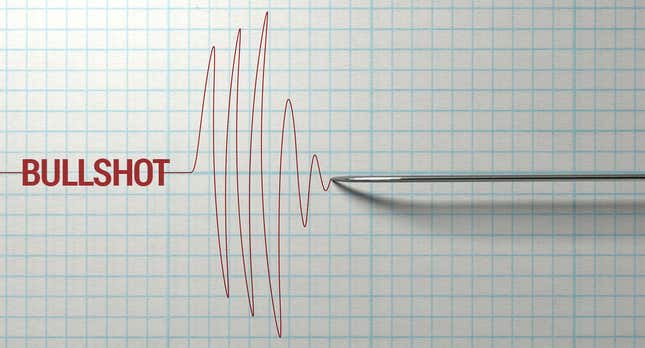
Consumers are smarter today than they used to be, but that hasn’t stopped video game publishers from releasing what have become known as “bullshots,” doctored images that are meant to show what a video game looks like, but end up being so modified and fancified they’re often nothing of the sort.
Think of it as a nip and tuck, only for a video game. While they’re useful for a publisher - the better their games look, the more they’ll sell - they’re the opposite for a gamer, as we’re essentially being told tiny lies, shown one thing then sold something else.
This story was originally published in November 2014.
Because the practice is still going on, even in this age of streaming and screenshot capture buttons, we figured it’d be worth having a chat with an artist who has actually worked on “bullshots,” to learn how they’re made.
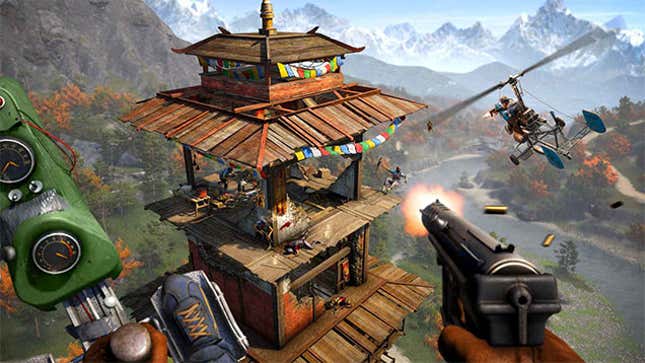
Here’s a recent example of a “bullshot,” in this case for Far Cry 4. While it is a visually impressive game, note the added touches here like soft edges on the spent casings and muzzle flash, and the rotors on the co-op chopper.
The artist, who we’ll call Frank (not his real name), has done bullshot work across a few generations of hardware, both console and handheld. Here’s how it worked for the major publisher employing him (note of course that different companies might have different approaches or policies regarding this stuff!):
“A few years ago I retouched game screen shots for a AAA company,” Frank says, adding the work he was doing was similar to “performing surgery.”
“How it works is I would be sent a bunch of raw screenshots in their native resolutions, with a list of notes on specific alteration.” He was expected to alter or replace stuff like:
- Jagged edges on objects would be smoothed out.
- Assets or effects clipping through other assets (like a gun not sitting in a character’s hand properly) would be altered, redrawn or removed.
- Blurry textures would be replaced with textures from other screens or even from photos depending on the graphical fidelity.
- Wheels or other round objects that did not look round enough would be redrawn.
- Reflective or shiny objects that did not have a highlight would have one added.
- Lighting inconsistencies would be cleaned up in Photoshop.
- Map or HUD overlays may have had to be added or removed as needed, while some would even be 100% fabricated for a screenshot.
- The overall image had to be sharpened so the shots could be used in a magazine or on a billboard.
- Games with an online component (but which weren’t yet online) would have player names added to make it appear as though units/models in a game were actual human players, even though they weren’t (though Frank adds that often, in fine print, these screens would carry a disclaimer noting this).
- If a screenshot did not have a planned environmental or weather effect (a storm or sunset, etc), then Frank would add them manually.
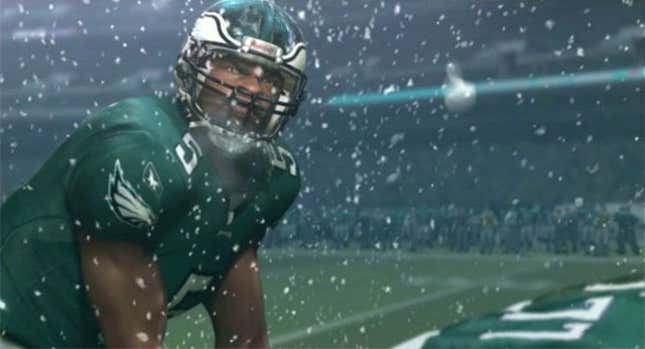
Penny Arcade coined the word “bullshot” in 2005 following the release of these Madden 06 screens, which looked nothing like the retail release.
Frank says that the amount of work, and the type of work done, varied depending on whether it was a handheld or console title. Handheld titles would need a lot more work done on their jagged edges and low-res textures, for example, while bullshots for HD console games were more about adding effects and swapping out game textures with those lifted from photos.
This was most common in areas where a difference in polygon count would make certain objects appear out of place (a detailed player model next to a low-detail car, for example). “At times it was possible to copy images from the internet, hack them up and manipulate them so that they would match the fidelity of other objects in the scene,” Frank says.
“Adding shine highlights on top of objects that had already had their textures replaced not only worked, it made the object look less doctored, as if it was rendered in-engine. That really was the goal. To present an idealized version of the scene while adhering to the limitations of the game’s engine.”
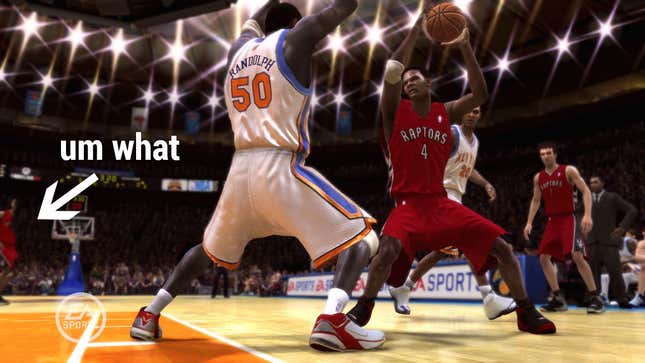
This NBA Live 08 screenshot is one of the all-time great bullshots, with a half-photoshopped player making it all the way from an artist’s computer to video game press releases without being noticed.
That limit meant that while Frank would always be striving to improve the original screenshot as much as possible, he could never adjust things like the number of characters on screen, or the weapon being used, etc. “There was never a time when we put things in that the game could not do,” he says, “even if they were facsimiles of those effects.”
Isn’t that wild? For a decade now, everyone has been assuming these screenshots were about improving how a video game looked, when in some cases it’s been about downgrading elements of actual photos!
Handheld games, meanwhile, couldn’t make use of this fix. “The fixing of jagged edges and low quality textures was the most prevalent and most difficult on the lower resolution titles,” Frank says. “I had to fabricate large portions of the scenes, while still making them look as though they were rendered at low resolution on the handheld.”
To illustrate just how shots like this are put together, I gave Frank a screenshot I captured from Call of Duty: Advanced Warfare on the PC. It’s from the game itself, not a cutscene, and while the pose looked like something you might see in an official screenshot, it was also mundane enough to look like, well, something I took by randomly pressing F12 in Steam.
I then asked him to bullshot it.
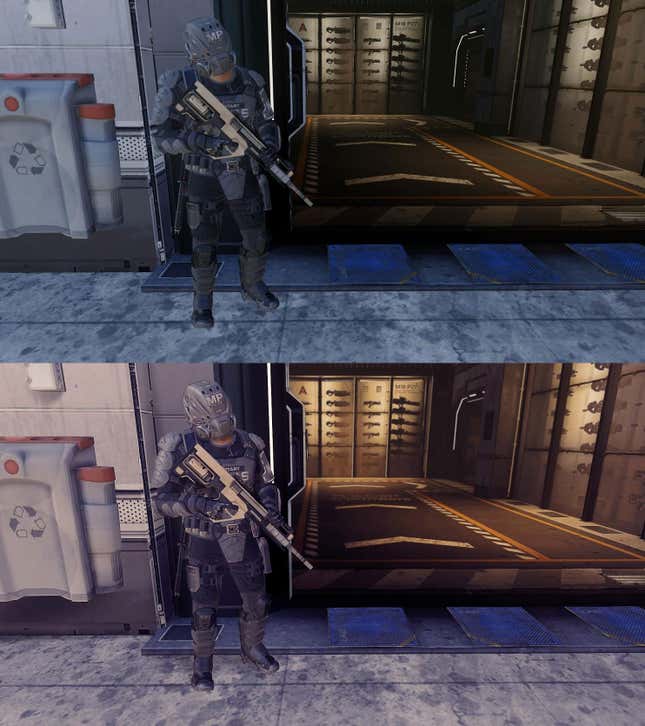
Up top is the original, undoctored screenshot. The bottom image is what Frank whipped up by doing stuff like:
- Adjusting the color and lighting.
- Softening the background (the gun rack and cargo door) to create a sense of depth.
- Moving the soldier’s left hand (it was “clipping” through the gun in the original) then redrawing the gun, as well as adding a shadow under the right hand.
- Adding light shadows and a gradient map.
- Using a high pass filter to make the image appear more “crisp.”
- Adding highlights to the soldier’s armor.
They’re relatively minor changes, yes, but that’s the point: to show how even subtle adjustments and effects can impact the presentation and quality of an image.
While screenshots have taken a backseat to trailers in terms of their importance to game marketing, they’re still around and are still seen by many as key indicators of how an upcoming title is shaping up. If that’s you, that’s cool, the prevalence of cinematic trailers has justifiably got you more interested in the “real” thing.
Just keep in mind: the real thing isn’t always as real as you hope it is.

